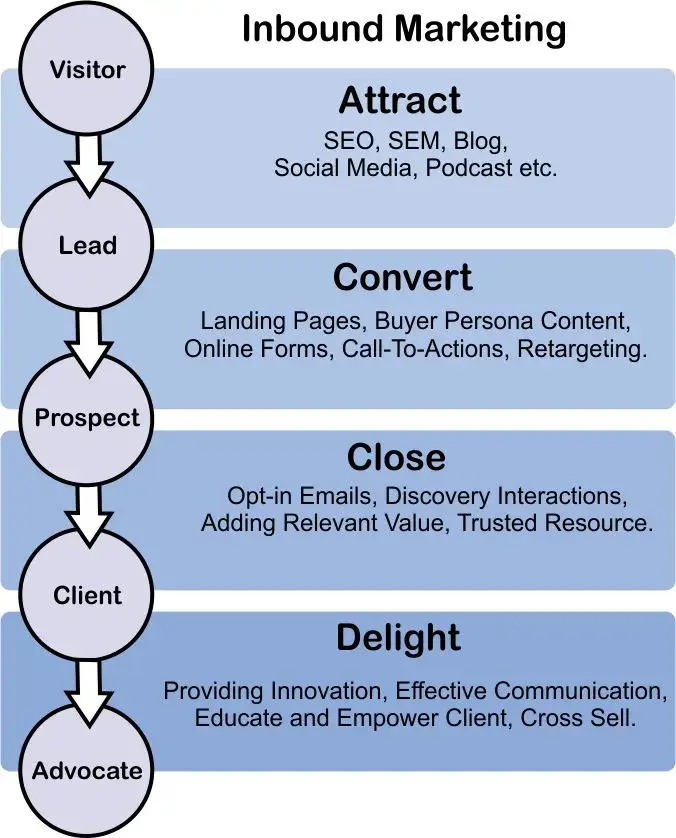Unraveling SEO and Inbound Marketing
In today's digital marketing landscape, two pivotal approaches, Inbound Marketing and SEO (Search Engine Optimization), wield distinct yet complementary powers. Both dedicated to boosting online presence, they possess different methodologies and goals. Let's provide some insight into these two approaches, while also underscoring their collaborative potential. Furthermore, we'll delve into how Geotargeting, a facet of search engine optimization, adds a localized dimension to overall online marketing efforts.
Empowering the Customer Journey
Central to Inbound Marketing is its customer-centric approach, focused on captivating and engaging users through valuable, solution-oriented content. Rooted in the philosophy of nurturing lasting relationships, It employs an array of techniques, including quality content marketing, social media engagement, marketing automation, and lead nurturing.
The user journey is central to Inbound Marketing. As users traverse the sales funnel, tailored content accompanies them, nurturing their engagement and transforming them into qualified prospects. The overarching objective is to create a loyal customer base, augmented by increased organic traffic and sustained brand advocacy.
Inbound Marketing Strategies Revolve Around Four Key Stages
Attract: Creating compelling content that resonates with your target audience, drawing them to your brand organically. This includes blog posts, social media updates, videos, and other engaging materials.
Convert: Once attracted, the goal is to convert visitors into leads by offering something of value, such as an e-book, webinar, or consultation, in exchange for their contact information.
Close: With leads nurtured through targeted email campaigns and personalized content, the focus shifts to closing sales by addressing specific pain points and offering tailored solutions.
Delight: Even after a sale, the relationship continues. Delighting customers with exceptional service, valuable resources, and a remarkable experience fosters loyalty and advocacy, potentially leading to repeat business and referrals.
SEO: Rising in Rank
Search Engine Optimization stands as a specific component or tactic within the broader Inbound Marketing framework. It revolves around optimizing your website's structure and content to secure higher organic rankings on search engine results pages (SERPs). It encompasses an array of its own tactics, including meticulous keyword research, on-page and off-page website optimization, strategic URL structuring, and judicious link building.
The chief aim of SEO is to bolster your website's discoverability and accessibility to online users actively seeking pertinent information or solutions. Achieving a prime spot in search results enhances your brand's credibility and reliability, consequently driving an upswing in organic traffic. This enduring strategy necessitates consistent efforts and a proactive approach to adapting to evolving search engine algorithms. It's not a quick-fix. It's an ongoing process.
Key Aspects of SEO Include
Keyword Research: Identifying the most relevant and high-volume keywords that your target audience is searching for, and incorporating them strategically into your content.
On-Page Optimization: Optimizing various elements of your website's pages, such as titles, meta descriptions, headings, and quality content, to align with your target keywords and provide a seamless user experience.
Technical SEO: Performing a website technical audit ensures the core areas are optimized for search engines, including factors like site speed, mobile-friendliness, and crawlability.
Link Building: Acquiring high-quality backlinks from authoritative and relevant websites, which signals to search engines that your content is valuable and trustworthy.
Synergizing Inbound Marketing and SEO
The potency of Inbound Marketing and SEO emerges when they come together. Inbound Marketing enables user engagement and relationship-building, while Search Optimization ensures targeted content reaches the right audience at the beginning stages. Since each person can be in different places of their journey, each touch point reached - Attract, Convert, Close, Delight - dictates how you interact with the individual. It changes based on which milestone they've reached. So imagine Inbound Marketing as a comprehensive recipe, with SEO acting as the quintessential spice that enhances flavor and appeal.
By aligning these two approaches, you create a cycle:
SEO drives targeted traffic: Through optimized content and technical enhancements, SEO attracts users actively searching for solutions related to your products or services.
Inbound Marketing nurtures leads: Data and insights from Inbound Marketing efforts inform ongoing SEO optimizations, ensuring your content remains relevant and visible to your intended audience.
Continuous optimization: Ensuring your website's technical foundation is optimized for search engines, including factors like site speed, mobile-optimized, and crawlability.
Increased brand authority: As you consistently deliver valuable content and positive user experiences, your brand's authority and credibility grow, further boosting your search engine rankings and attracting more organic traffic.

Within the realm of Search Engine Optimization, Geotargeting emerges as a critical facet. It tailors content to specific geographical regions, effectively connecting with local audiences. This inclusion augments local visibility, offering meaningful interactions with potential customers nearby. By fusing Geotargeting into your SEO strategy, you amplify engagement and resonate more profoundly within your community.
Techniques Include:
Local Keyword Research: Identifying location-specific keywords and phrases that your local audience is searching for.
Localized Content Creation: Developing content that addresses the unique needs and interests of your local market, incorporating relevant local references and information.
Local Citations and Listings: Ensuring your business is accurately listed and cited across various online directories, maps, and review platforms relevant to your local area.
Localized Link Building: Acquiring backlinks from locally relevant and authoritative websites, further boosting your local search visibility.
Conclusion:
Inbound Marketing and Search Engine Optimization interlace their unique strengths while pursuing separate trajectories. One champions the art of building relationships and shepherding the customer journey, while SEO magnifies visibility and accessibility as a way to cross paths with the individual in their journey. As these converge, a dynamic synergy ensues, propelling your brand's awareness in the digital realm. Geotargeting, a SEO subset, enriches the endeavor further by increasing local exposure. By embracing both Inbound Marketing and SEO, alongside the application of Geotargeting, you equip yourself with a comprehensive toolkit for achieving your brand's position as a formidable presence in the digital landscape.


